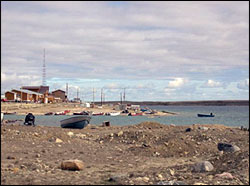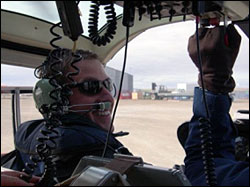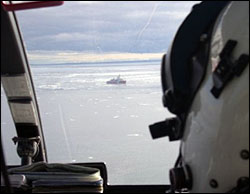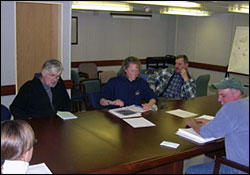Please note: You are viewing
the unstyled version of this website. Either your browser does not support CSS
(cascading style sheets) or it has been disabled. Skip
navigation.
Rick KrishfieldAugust 5-6, 2004
Several members of the science party were already on board the ship (including the Chief Scientist, Sarah Zimmermann, from the Institute of Ocean Sciences (IOS) in British Columbia), but the remainder were retrieved from Cambridge Bay by the ship’s helicopter and transported to the vessel which lay waiting several miles offshore. Those who had never flown in a helicopter before were excited by this adventure, including WHOI Engineering Assistant II, Kris Newhall. After a safety briefing by First Officer Rod Strowbridge, most scientists spend their first night on the LSL moving into their cabins and meeting the officers and crew. On the following day, the first science meeting takes place in the board room. In addition, the Commanding Officer of the LSL, Andrew McNeill formally welcomes the scientists, and Third Officer Wayne Pelley provides a familiarization briefing. Later there is the mandatory Fire and Boat drill, where everyone onboard dons their lifejackets and heads to their respective stations, as practice in case of an emergency. Altogether there are 64 people on this cruise: 48 officers and crew, and 16 scientists. This expedition is the third JWACS cruise for scientists from Canada and Japan, as well as the second cruise of the NSF funded BGFE experiment. Everyone onboard is excited to participate on this voyage of scientific exploration, and can’t wait to get started. According to the ship’s ice observer, Dan Crosbie, the ice conditions in the Beaufort Sea are still very extensive, so it won’t be long until we reach the main icepack. Last updated: October 7, 2019 | ||||||||||||||||||||||
Copyright ©2007 Woods Hole Oceanographic Institution, All Rights Reserved, Privacy Policy. | ||||||||||||||||||||||






